Nor-Shipping: Wind-Assisted Propulsion is Finally Taking Off

Wind-assisted propulsion is having a moment in commercial shipping. On average, most systems on the market can reduce fuel consumption by about 10 percent for a tanker or bulker - or more, if the conditions on the route are right. Design maturity is increasing, along with economies of scale for manufacturing, bringing down capex and shortening payback times for the shipowner. It's not just a matter of whether it's the right thing to do; it is getting to the point where it makes economic sense, especially when factoring in carbon-pricing mechanisms like FuelEU Maritime and the IMO MEPC 83 fee structure.
The latest example is the Brands Hatch, a new Aframax built by CSSC Shanghai Waigaoqiao, one of China's premier state-owned shipyards. Brands Hatch - built for UK-based Union Maritime - has three 40-meter fiberglass sails from BAR Technologies on deck. These giant "WindWings" are capable of generating enough propulsive force to save about 14 tonnes of fuel per day, naval architecture researcher Huang Yiming of Shanghai Waigaoqiao told CGTN.
Union Maritime is far from the only owner experimenting with wind power. Odfjell recently installed four self-tending suction sails from Bound4Blue on the tanker Bow Olympus. The installation was easy, Odfjell board member Jan Kjaervik told TME at Nor-Shipping. The pedestal supports for the system were welding on at a yard in China during a shipyard period, and the sails themselves were mounted up in a matter of days at EDR Antwerp Shipyard. No physical changes were required to meet stability requirements after adding the additional mass and lateral force at deck level.
So far, the Bow Olympus' operating experience shows that the system captures some amount of wind energy about 70 percent of the time.
Bound4Blue CTO and co-founder David Ferrer emphasizes that suction sails are compact and comparatively simple, retaining the performance of a Flettner rotor in a less complex package. "Small size means that it can be built out of steel, without having an enormous cost, weight increase. It has greater simplicity, because there are no big moving parts, so maintenance should be reduced," he told TME.
Crew feedback has been positive, in part because a vessel with sails experiences less rolling under most wind conditions. "It's more comfortable to be on board the vessel now. It has a stabilizing effect," said Kjaervik. "The vessel is rolling less than it used to do."
For owners who are looking to follow this path, certification and data are essential, and that falls neatly into the role of class societies. In a recent study for rotor sail builder Anemoi, Lloyd's Register - which has been evaluating sail-powered vessels since 1760 - validated the company's performance measurement process, providing assurance that owners can determine how well the system works in practice.
"Owners understand that this is actually a viable option for them to reduce emissions and reduce costs and reduce penalties. So I think that higher fuel prices and the [carbon] taxes really start to bring us closer to the point where owners accept it on a broader basis," says Claes Horndahl, Commercial Director at Anemoi.
Tankers are an easy use case for sail equipment because they have minimal cargo operations over the main deck level. Large bulkers on long-haul routes perform well on a return-on-investment basis, and for these vessels, sail system OEMs have developed a variety of methods for folding down or moving aside the equipment to enable cargo operations with cranes or grab buckets. In the industrial environment of a bulker in port, the sail equipment has to withstand the usual knocks and dings, like any other deck machinery. That moment of practical maturity has arrived, Horndahl says. "We have performed drop tests, and the GRP we are using is very resilient to falling pieces, if that were to occur," he says.
